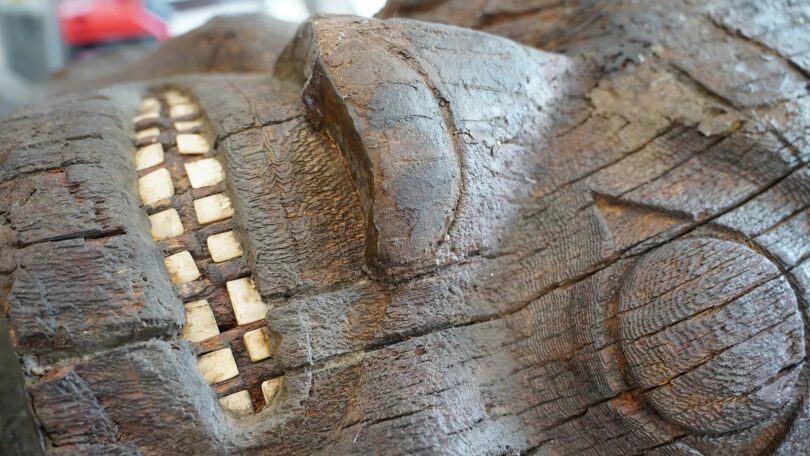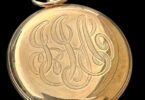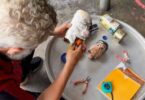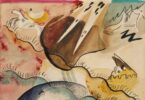Diane Selkirk
Somewhere in the dense coastal forests surrounding Txaa K’alii Aksim Lisims (the Nass River) in what would become north-western British Columbia, Canada, master carver Oye’a’ of the Indigenous Nisg̱a’a people picked out a towering red cedar tree. After giving a blessing, he removed the bark around its base, girdling the tree. Over the next decade, the cedar dried from the inside out. By the 1850s, when it was felled for carving, it was light and strong enough survive for a century or two.
Commissioned to create a memorial pole by Joanna Moody, the matriarch of the House of Ni’isjoohl of G̱anada or Raven/Frog clan in Ank’idaa Village, an island in the middle of the Nass River, Oye’a’ stripped off the bark and brought the log to his workplace. Carving the story of Ts’wawit, a young warrior in line to be chief who was killed during a skirmish with Tsimshian warriors, and G̱anada’s traditional histories, Oye’a’ breathed life into the pst’aan (pole).
Even as the Ni’isjoohl memorial pst’aan was brought alive with the spirit of ravens, a white bullhead and the chief, life in the Nass Valley was changing. Captain George Vancouver was the first European to record encountering the Nisg̱a’a while charting the Pacific Coast from 1791-95. Then the fur trade got underway. In the 1830s, a Hudson Bay Company trading post was established in the heart of the territory, bringing smallpox, measles and other diseases, and destabilising the relationships between neighbouring Nations. Then, in 1860, gold was discovered. Worried about losing control over the region (and the gold), the British colonial office created the Colony of British Columbia, placing the entire Nass Valley within its domain.
From its headwaters in the glaciers of the Skeena Mountains, the Nass flows south-westerly for 380km before draining into Portland Inlet and the Pacific Ocean. Ringed by glacier-capped mountains; forests of hemlock, pine, balsam, aspen and alder flank the hillsides, gradually giving way to red cedar, spruce and hemlock as you near the coast. Meadows thick with soapberry, salmonberry and kinnikinnick plants entice deer, moose and porcupine. Eulachon and five species of salmon return to the Nass each year, attracting black bears, grizzly bears, wolves, ravens and bald eagles.
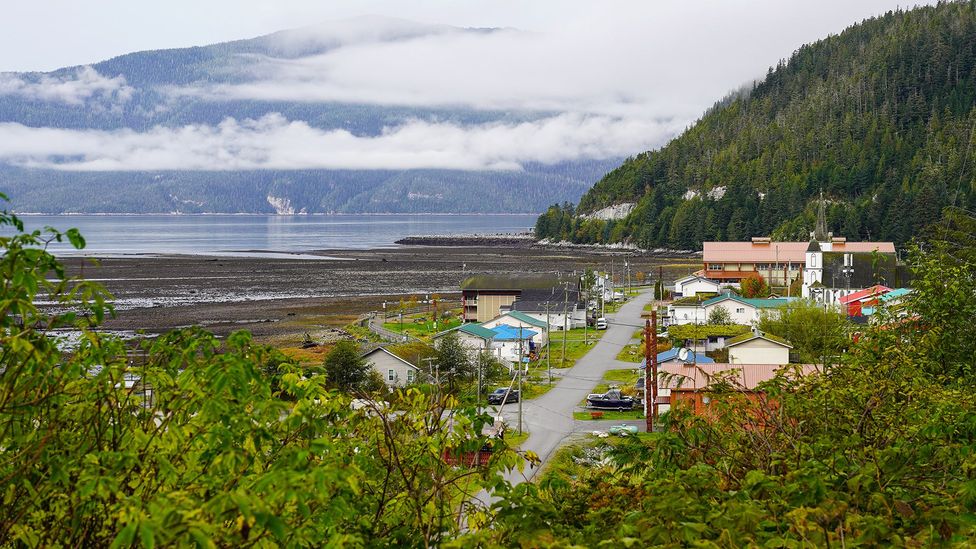
Gingolx is one of four Nisg̱a’a villages in the Nass River valley of north-western British Columbia (Credit: Diane Selkirk)
Life in Ank’idaa followed the seasons; people travelled for fishing, berry harvesting, hunting or trapping. Strict protocols and intricate social structure kept the community and ecosystems in balance. Around 1855, Oye’a’ would have delivered the Ts’wawit’s memorial pole from his home village of Gitwinksihlkw, 30km up the river from Ank’idaa. The House of Ni’isjoohl likely raised it with a feast and ceremony commonly known as a potlatch. Wealth was shared, traditional names were passed along and the pst’aan’s presence ensured the transmission of knowledge to the next generation.
Then, in 1884, the federal government of Canada enacted the Potlatch Ban, an amendment to the Indian Act of Canada, with a goal of crushing Indigenous culture. At the same time, disease kept coming. Missionaries pushed Indigenous people to assimilate into the growing settler population, warning them their “pagan” ways were to blame for their tragedies. By 1889, the Northwest Coast Indian Agency census counted 805 Nisga’a people; a population decline of 82-99%.
In Ank’idaa, the ancestors – as the Ni’isjoohl pst’aan and other poles are known to be – watched over their ravaged village. In 1920, it became mandatory for Indigenous children to attend residential school. Stolen away, many never returned home. In 1927, Marius Barbeau, anthropologist with the National Museum of Canada, first visited the Nass. In what he characterised as anthropological rescue, he voraciously scooped up the ceremonial and sacred belongings of what he called a “dying race”.
Coerced by missionaries and federal Indian agents, some Nisga’a parted with their possessions (others had their belongings destroyed). When Barbeau couldn’t get permission to take things, he took photos. An image of the Ni’isjoohl pst’aan caught someone’s eye at what’s now the National Museum of Scotland. After Barbeau negotiated a price between C$400 and C$600 (£240 and £360) to cover costs (no money was paid to the Nisga’a), he returned to the Nass in 1928. When Ank’idaa was empty during fishing or harvesting season, Barbeau and his team cut down most of the pst’aans in Ank’idaa, bundled them into a raft, and floated the ancestors down the Nass and onward to museums around the world.
By 1929, the stolen 36ft-tall Ni’isjoohl pst’aan was on display in Edinburgh.
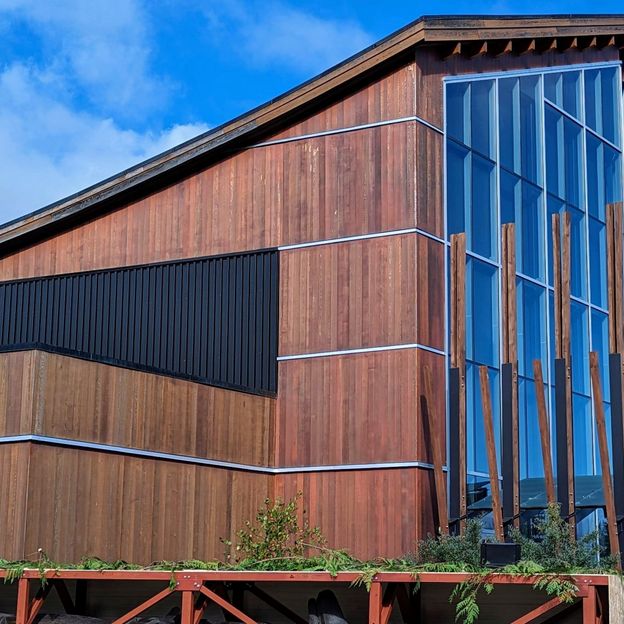
The House of Ni’isjoohl memorial pole will be raised inside the Nisga’a Museum and watch over another generation of Nisga’a youth (Credit: Diane Selkirk)
The decades that followed were a dark time for Indigenous people in Canada. Physically, culturally and spiritually abused, they had few rights. But through the horror, the Nisga’a focused on the future.
On 11 May 2000, the Nisga’a and the governments of Canada and British Columbia signed the province’s first modern treaty, the Nisga’aa Final Agreement. In addition to codifying the Nisga’a’s right to self-governance, ownership of 2,020 sq km of hereditary land and access to traditional foods, the treaty paved the way for more than 300 stolen belongings to be returned to the Nisga’a from Canadian museums. But there was a stipulation; the returned belongings had to be conserved in a Class-A museum with humidity and temperature controls, a cost-prohibitive condition the Nation spent $17m to meet.
Designed after traditional longhouses, the glass-fronted Nisg_a’a Museum opened in 2011 in Laxgalts’ap, a few miles downstream from Ank’idaa Village. According to Theresa Schober, the museum’s director and curator, the initial return of masks, bentwood boxes, regalia and other ceremonial items are just a portion of the Nisg_a’a belongings scattered around the world, but their recovery is “reconnecting all Nisg_a’a [houses and clans] to ancestral belongings as equally as possible.”
Now visitors can learn from the Nisg_a’a on their own territory and on their own terms; a profound and healing experience, for everyone. “Young community members bring guests through the Ancestors’ Collection, sharing their own stories and oral histories,” said Schober. “It’s very different than seeing these belongings out of context, surrounded by unrelated objects.”
Sigidimnak’ Noxs Ts’aawit (Amy Parent) hadn’t expected to spend the past year thinking about the colonial-burdens of repatriation policy. As the Canada research chair in Indigenous education and governance at Simon Fraser University in British Columbia, Parent was meeting with Elders in Laxgalts’ap when Sim’oogit Ni’isjoohl (Chief Earl Stephens) asked her to look into the Ni’isjoohl memorial pole.
Ts’awit (Calvin McNeill) a master carver from the House of Ni’isjoohl, who lives in Laxgalts’ap and spent years studying his Nation’s belongings in museums had carved a replica from historical and contemporary photographs, but before the community could raise it, Parent said, “they needed more information about names connected to the original Ni’isjoohl pole”. Learning it was in Edinburgh, Parent reached out to National Museums Scotland (NMS). The details she found made her stomach lurch; her great-great-great-grandmother Joanna Moody had commissioned the pole, and both she and McNeill carried versions of the young warrior’s name.
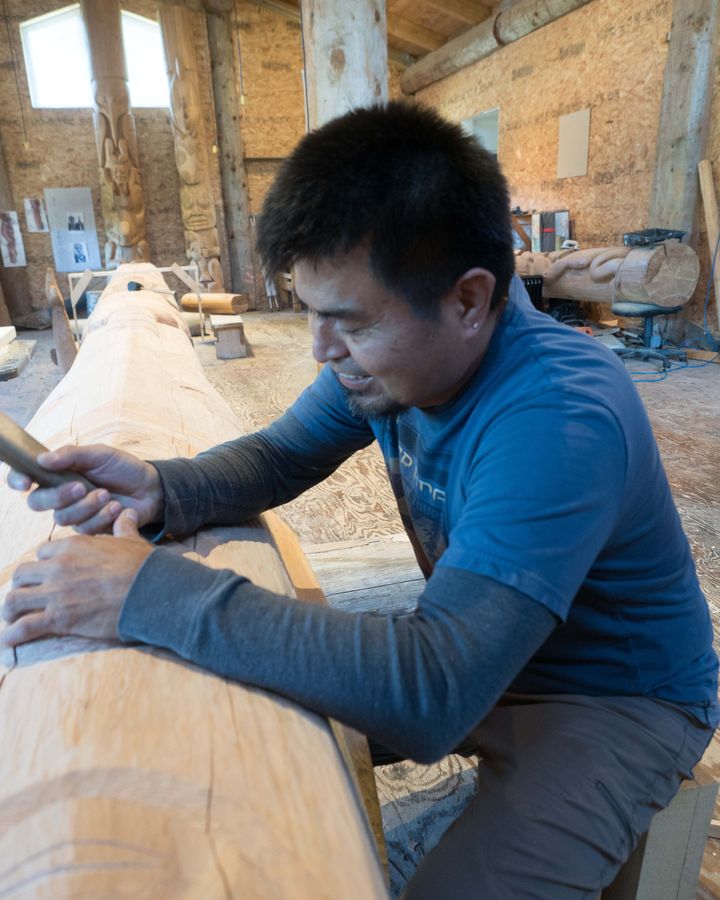
Calvin McNeill is often found in the carving shed in Lax̱g̱altsʼap working on projects (Credit: Diane Selkirk)
What followed could have gone the way of other failed repatriation efforts. In August 2022, just before a seven-person Nisga’a delegation, including Parent, Stephens and Schober (as a non-Nisga’a witness), journeyed to Scotland to ask for the pole back, Schober estimated it could be a five- to seven-year process. Almost immediately, the Nisga’a delegation and NMS staff clashed. “First it was around our ceremonies to feed the pole [because] they had a ‘no-food-in-the-museum’ rule,” said Parent. (The two groups compromised by using vacuum-packed food.) “Then they told us to follow their very complicated, one-year-old repatriation policy.”
We let the people of Scotland know that we wanted the spirit of the pole to be free… with our people where it can teach the next generation who we are
Instead, the Nisg̱a’a did what they do best: they invited NMS staff to learn who they are and why the pst’aan needed to go home. “We let the people of Scotland know that we wanted the spirit of the pole to be free… with our people,” said Parent, “where it can teach the next generation who we are.”
Describing the pst’aan’s return as “a rematriation”, reflecting the fact the Nisg̱a’a are matrilineal and the return would bring balance, Parent says the pst’aan must be powerful because the process began to move with unprecedented speed and ease. On 1 December 2022, NMS’ Board of Trustees agreed the Ni’isjoohl memorial pole could go home. Plans came together through the year and in August 2023 the delegation returned to Edinburgh for a private ceremony to prepare the pst’aan for the journey home – assuring it that it didn’t have to keep enduring the cacophony of strangers. Packed in a protective crate, swathed in cedar bows, the pst’aan was lovingly moved by NMS staff through the dismantled gallery out into a closed street and to the airport where it was loaded into the belly of a Canadian Armed Forces aircraft for a journey to Terrace, BC.
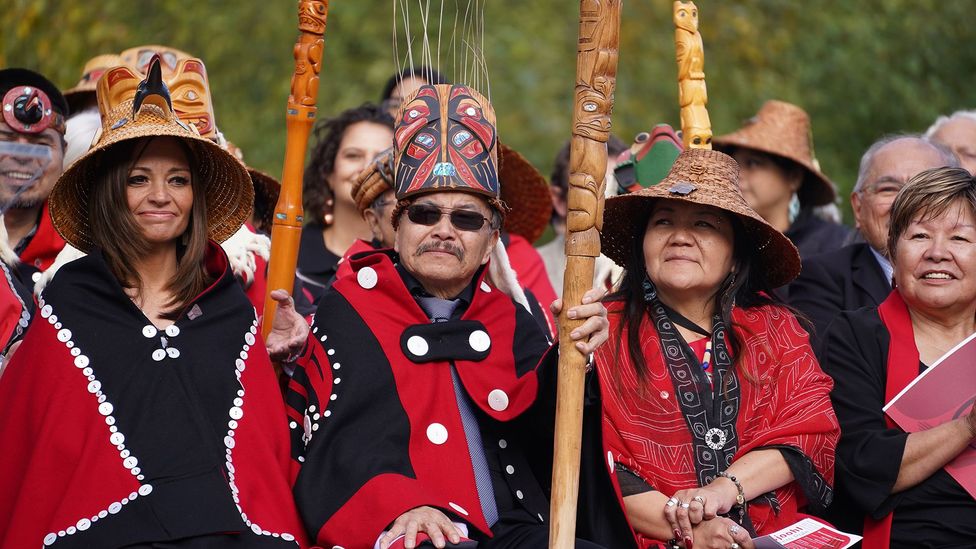
Officials from the Nisga’a Nation welcomed the return of the memorial pole 94 years after its removal (Credit: Diane Selkirk)
On 29 September, just in time for Canada’s National Day for Truth and Reconciliation, a procession guided the Ni’isjoohl memorial pst’aan along the 150km drive on Nisg̱a’a Highway 113. Winding past lakes and streams, it travelled through a massive expanse of lichen-covered lava, a reminder of when the Tseax volcano erupted in 1700, spilling molten rock across the landscape, destroying at least two villages and killing an estimated 2,000 people.
Reaching the swift waters of the Nass, it passed Gitwinksihlkw, the place where it was carved. Then it plunged into the same misty forest where it once grew and that now hid signs of its ancient home village of Ank’idaa. Arriving in Laxgalts’ap, it was privately greeted by its family and unclad for the ceremony. Then the crowd began to grow. Dressed in red and black regalia, Nisg̱a’a dancers, drummers and singers filled the valley with song. As Elders spoke and prayed in Sim’algax, the mist burned off and, for the first time in 94 years, the pst’aan felt the sun.
Parent couldn’t help but note that everything had come full circle. “Through our songs, through our dances”, Parent says they were able to change hearts, minds and policy. The pst’aan was home.
Courtesy: BBC

